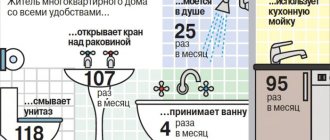Daily calorie intake is the amount of energy the body needs to function and maintain metabolism. Reducing calorie intake by 15-20% per day leads to weight loss, while to gain muscle mass, athletes must increase the caloric content of the daily diet.
You can calculate the calorie intake either using the Harris-Benedict formula, or determine the average figure using the tables - they are presented below. However, ultimately, the formula calculation does not take into account that a person's caloric needs always vary.
Calculation of calorie intake - formula
Calculating your daily calorie intake begins with determining your basal metabolic rate (BMR)—the energy your body needs to function. The figure includes calorie needs for brain function, maintaining body temperature, digesting food and metabolic processes.
However, BMR does not take into account physical activity - and from 20 to 90% of daily calories are spent by the body not on metabolism, but on everyday movement. Depending on the level of load, an additional human activity coefficient is selected (from 1.2 to 1.9), by which the BMR figure is multiplied.
Harris-Benedict formula
The first version of the formula for calculating calorie intake was presented in 1919 by anthropologists James Arthur Harris and Francis Gano Benedict. To compile the formula, they studied 239 subjects of different genders and ages with different percentages of body fat. The formula was revised and refined in 1984².
// Formula for calculating the basic calorie intake:
- for men: BMR = 88.36 + (13.4 x weight, kg) + (4.8 x height, cm) – (5.7 x age, years)
- for women : BMR = 447.6 + (9.2 x weight, kg) + (3.1 x height, cm) – (4.3 x age, years)
To determine the body's daily caloric needs, you need to multiply the BMR corresponding to your gender, age and weight by the activity factor. In turn, this coefficient is determined depending on the level of physical activity on a particular day.
Daily activity rate
The Harris-Benedict formula for calculating daily calories defines five types of physical activity. Minimum level (no exercise), low level (physical activity 1-3 times a week), medium level (3-5 days a week), high level (6-7 times) and very high level (exercise more than once a week). day).
However, it is in the activity coefficient that the key problem with any calorie calculation formula lies. Once your BMR is accurately calculated (eg 1765 kcal), you need to multiply the figure by your activity factor, which ranges from 1.2 to 1.9. The final result will be from 2118 kcal to 3354 kcal - a difference of 1236 kcal.
// Activity coefficients when calculating calorie intake:
- Minimum activity level - 1.2
- Low activity level - 1.375
- Average activity level - 1.55
- High level - 1.725
- Very high - 1.9
How to calculate your daily calorie intake to lose weight without harming yourself
Calculate calorie needs
At the first stage, we will calculate the basal metabolic rate (BMR) - the number of calories that the body needs to receive during the day for normal functioning at rest.
That is, this is the amount of energy spent per day on breathing, digesting food, tissue repair and growth, and blood circulation. This value can be determined in two ways: using the Harris-Benedict equation and based on the Mifflin-St. Jeor equation. Let's take, for example, a pair of young people with a body mass index of 27.78 (a young man of 30 years old, 1.8 m tall and weighing 90 kg) and 25.71 (a 25-year-old girl 1.65 m tall and weighing 70 kg). According to WHO definitions, they are overweight or even obese. It’s probably not very noticeable in clothes, but the “ears” on the sides won’t let you lie.
Harris-Benedict formula
Francis Gano Benedict was an American chemist, physiologist, and nutritionist who was one of the pioneers in the study of metabolic rate and oxygen consumption. In 1919, he published the scientific work A Biometric Study of Basal Metabolism in Man, which later became an absolute classic in its field. The co-author of the work was Francis's compatriot, botanist James Arthur Harris. The scientists stated that the approximate value of BMR can be determined based on body surface area and proposed a corresponding formula.
In 1984, changes were made to the original calculations. By the way, many online daily calorie calculator calculators have not heard about these adjustments. We will provide an updated version. Just familiarize yourself with it and take your time to count.
Calculation for men: 88.362 + (13.397 × weight [kg]) + (4.799 × height [cm]) − (5.677 × age [years]).
88.362 + (13.397 × 90) + (4.799 × 180) − (5.677 × 30) = 88.362 + 1,205.73 + 863.82 − 170.31 = 1,988 kcal/day.
Calculation for women: 447.593 + (9.247 × weight [kg]) + (3.098 × height [cm]) − (4.33 × age [years]).
447.593 + (9.247 × 70) + (3.098 × 165) − (4.33 × 25) = 447.593 + 647.29 + 511.17 − 108.25 = 1,498 kcal/day.
The 95% confidence interval is ±213.0 kcal/day for men and ±201.0 kcal/day for women.
Mifflin-Geora formula
This formula was created in 1990 in response to changing lifestyles over the past 100 years.
Calculation for men: 5 + (10 × weight [kg]) + (6.25 × height [cm]) − (5 × age [years]).
5 + (10 × 90) + (6.25 × 180) − (5 × 30) = 5 + 900 + 1,125 − 150 = 1,880 kcal/day.
Calculation for women: (10 × weight [kg]) + (6.25 × height [cm]) − (5 × age [years]) − 161.
(10 × 70) + (6.25 × 165) − (5 × 25) − 161 = 700 + 1,031.25 − 125 − 161 = 1,445 kcal/day.
Subtotals
As you can see, different approaches give slightly different results. Which formula do you prefer? For an answer, I turned to professionals - employees of the BODYCAMP company.
Natalya Nefedova
Dietician, nutritionist, psychologist, author of scientific works.
There are many more formulas (for example, The Institute of Medicine Equations, Danowsky Equation and others) for determining the daily calorie limit, and each of them is good for a nutritionist in its own way. For example, I use separate formulas if I am assessing a patient in an inpatient setting. Any serious illness is stress, which increases metabolism and, as a result, calorie consumption. Not to mention the case if the patient has a fever. There are formulas that should not be used for obese or overweight patients. The Harris-Benedict formula is one of them. She overestimates the daily calorie limit by 5–15% (and, on the contrary, underestimates for men over 65 years of age).
At the moment, researchers are inclined to believe that the Mifflin-Geor and WHO formulas give the closest result to the truth. These formulas can only be used by healthy people with normal body weight. However, I advise you not to consider the resulting value as a panacea. There are many factors that can affect metabolism, shifting it in one direction or another, for example, medications, muscle mass, spicy foods, smoking, and so on. Calculating your daily calorie limit is just one of the tools that will help you stay fit and healthy.
By the way, Natalya graduated from McGill University (Canada) and has been working in her specialty for nine years. Let's take her advice and focus on the Mifflin-Saint-Geor equation. Let's move on to the second step.
Making allowances for physical activity
No matter how much we would like an eternal Sabbath, it only happens once a week. And the rest of the time we work, do housework and, in general, overcome laziness. This takes energy, which must be taken into account in the total amount of energy consumption. For this, correction factors are applied:
- 1.2 - if your activity mainly comes down to moving from bed to sofa;
- 1.375 - if you are more active and drown out your conscience with light training 1 to 3 times a week;
- 1.55 - if you are comfortable with moderate exercise 3 to 5 times a week;
- 1.725 - if you load yourself with heavy training 6-7 times a week;
- 1.9 - if you give it your all (work physically, train twice a day, do strength exercises).
Let's assume that our fictional characters are typical office workers. Their sedentary lifestyle corresponds to the first point. We will use it in our calculations.
1,880 × 1.2 = 2,256 kcal/day and 1,445 × 1.2 = 1,734 kcal/day.
But how to wisely manage these numbers? Let's explain now.
Reducing calorie intake
We are all adults and we are aware that losing too much weight will worsen our health, especially if it is not at all Siberian. You need to lose weight gradually so as not to expose your body to stress. So how much should the ration be cut? Let's turn to the experts again for advice.
The simplest rule used by nutritionists (at least in North America) is minus 500 kcal per day, or 3,500 per week. Such a deficiency will result in a loss of 500 grams of fat mass per week. However, it is recommended to lose weight over six months. Then the daily calorie limit is recalculated and the weight is maintained for another six months. If necessary, the algorithm is repeated. Thus, 250–500 g (depending on initial body weight) is the maximum safe weight loss per week. Exceeding this figure means loss of muscle mass and water. Again, this is not a panacea. Metabolism changes and will constantly and rapidly increase if a person, in addition to modifications in the diet, exercises regularly. Therefore, this figure will also need to be changed. I advise you to use this rule yourself for those for whom the desired weight loss is no more than 5 kg of fat mass. For the rest, unfortunately or fortunately, it is better to consult a specialist. I would also like to add that you should not consume less than 1,200 kcal per day. This will certainly lead to a lack of both micro- and macroelements.
Natalya Nefedova
We get that our fictional couple must reduce their daily calorie intake to the following levels:
2,256 − 500 = 1,756 kcal/day and 1,734 − 500 = 1,234 kcal/day.
Please note that the figures obtained are less than the base metabolic rate, with the girl generally approaching 1,200 kcal per day. This can be dangerous: the body will begin to burn muscle mass. Therefore, our heroes should increase their daily calorie intake to the BMR level, even if the weight loss goes a little slower.
If our young people were more active, their daily calorie needs would look like this:
1,880 × 1.375 = 2,585 kcal/day and 1,445 × 1.375 = 1,987 kcal/day.
Subtract 500 kcal and get values exceeding BMR:
2,585 − 500 = 2,085 > 1,880 kcal/day and 1,987 − 500 = 1,487 > 1,445 kcal/day.
How to monitor your diet
Research shows that people who keep a food diary follow their diet more strictly and lose fat faster than those who don't. By clearly understanding the caloric content of food sent to the stomach, it is easier to pull yourself together and close your mouth in time.
Record each meal you eat in your diary and calculate your total calorie content. There is no need to memorize the energy value of all products. It is enough to know the caloric content of popular dishes, imagine 200 calories in pictures, or capture in your memory the main points from the video “What 2,000 calories look like.” Although, of course, it’s easier to keep some kind of electronic calorie calculator on hand, for example, Dialife for iOS.
Conclusion
In conclusion, I will cite the opinion of Ekaterina Jensen, the author of many Lifehacker publications on the topic of healthy eating, who Fr.
Therefore, you should not take the calculation of your daily calorie intake as a “diet pill” - it may simply not work due to your physiological characteristics and health status. It’s worth a try, but if your health worsens or there are no results, you should seek help from a nutritionist.
How to calculate your daily calorie intake?
Here are some examples of calculating daily calorie intake using the Harrison-Benedict formula:
1. Male, 25 years old , height 178 centimeters, weight 72 kilograms, plays sports three times a week, the rest of the days he works in the office:
- BMR = 88.36 + (13.4 x 72) + (4.8 x 178) – (5.7 x 25) = 1765 kcal
- Calorie Value = BMR x Activity Level = 1765 x 1.55 = 2735 kcal
2. Woman, 25 years old , height 172 centimeters, weight 50 kilograms, goes in for fitness four times a week, leads an active lifestyle, being on the move most of the day:
- BMR = 447.6 + (9.2 x 50) + (3.1 x 172) – (4.3 x 25) = 1333
- Calorie Value = BMR x Activity Level = 1333 x 1.725 = 2299 kcal
// Online calculator for calculations
How to use a calculator to calculate calorie intake:
- Select metric system
- Please indicate your gender (“male” – male, “female” – female)
- Enter the number of complete years (“age”)
- Enter your height in centimeters (“height”)
- Enter your current weight in kilograms (“current weight”)
- Specify your activity level (“sedentary” – sedentary lifestyle, “light activity” – sedentary, “moderate” – mobile, “very active” – very active).
- Click the button to calculate (“calculate”)










